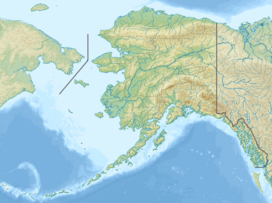Pyramid Peak (Unalaska Island)
| Pyramid Peak | |
|---|---|
 North aspect | |
| Highest point | |
| Elevation | 2,136 ft (651 m)[1][2] |
| Prominence | 1,200 ft (366 m)[3] |
| Parent peak | Peak 2417[3] |
| Isolation | 2.13 mi (3.43 km)[3] |
| Coordinates | 53°50′41″N 166°32′13″W / 53.8447514°N 166.5369517°W[4] |
| Geography | |
 | |
| Interactive map of Pyramid Peak | |
| Location | Aleutians West Census Area |
| Country | United States |
| State | Alaska |
| Parent range | Aleutian Range[5] |
| Topo map | USGS Unalaska C-2 |
| Geology | |
| Rock type | Andesitic |
Pyramid Peak is a 2,136-foot-elevation (651-meter) summit in Alaska, United States.
Description
[edit]Pyramid Peak is part of the Aleutian Range.[5] This iconic landmark of the Dutch Harbor area is set two miles (3.2 km) south of Unalaska on Unalaska Island of the Aleutian Islands. Precipitation runoff from the mountain drains into Captains Bay and Iliuliuk Bay. Topographic relief is significant as the summit rises over 2,100 feet (640 meters) above tidewater of Captains Bay in approximately one mile (1.6 km). The mountain's descriptive toponym was published in 1875 by the United States Coast Survey and has been officially adopted by the United States Board on Geographic Names.[4]
Climate
[edit]According to the Köppen climate classification system, Pyramid Peak is located in a subpolar oceanic climate zone with cold, snowy winters, and cool summers.[6] Winter temperatures can drop to 0 °F with wind chill factors below −10 °F.
Gallery
[edit]-
Pyramid Peak (center) viewed from airport at Dutch Harbor
See also
[edit]References
[edit]- ^ Donald J. Orth, Dictionary of Alaska Place Names, U.S. Government Printing Office, 1967, page 785.
- ^ Traveler Terpening, Alaska, Bradt Travel Guides, 2010, ISBN 9781841622989, p. 383.
- ^ a b c "Pyramid Peak - 2,150' AK". listsofjohn.com. Retrieved November 22, 2023.
- ^ a b "Pyramid Peak". Geographic Names Information System. United States Geological Survey, United States Department of the Interior. Retrieved November 22, 2023.
- ^ a b "Pyramid Peak, Alaska". Peakbagger.com. Retrieved November 22, 2023.
- ^ Peel, M. C.; Finlayson, B. L.; McMahon, T. A. (2007). "Updated world map of the Köppen−Geiger climate classification". Hydrol. Earth Syst. Sci. 11. ISSN 1027-5606.


